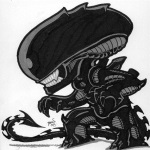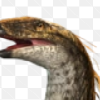
I Meme Everything
MemberAllosaurusNov-02-2018 7:15 PMPrologue: Precambrian

This is Earth, four and a half billion years ago; a Hellish, volcanic wasteland in which no life could exist. Its surface is bombarded by meteors. Clouds of toxic chemicals suffocate the atmosphere. It seemed that the Earth was destined to remain a lifeless planet; but then, something happened that would change the planet’s destiny.
A planet around the size of Mars, Thea, slammed into the Earth, birthing a new world; one in which life could exist. A smaller piece of Thea was hurled into space and molded into our moon. Slowly, meteors containing water molecules formed the oceans as the atmosphere saw an increase in oxygen. Life could finally exist; but what form would it take?
This series tells the largest story of all: the story of life, from the first advanced organisms, to the dinosaurs, to the last Ice Age. we will trace back life from the days of the Cambrian, and take you on a journey through millions of years to the Holocene. This, is Life: A 540 Million Year Journey.
Part One: Cambrian, 535 MYA
China, five-hundred and thirty-five million years ago. At this point in prehistory, all life resides in the ocean, as land does not yet have enough oxygen to support Cambrian life-forms. Life has begun its first great diversification, the Cambrian Explosion. This has seen many great advances in evolution, forming the basis for every organism to live after. This also means that ecosystems are becoming more advanced, as seen by the world’s first super-predator: Anomalocaris.
This is a bizarre animal, like nothing alive today. His body is protected by tough, hard plates of armor, forming an exoskeleton that will be passed down to his arthropod descendants like scorpions. He searches the ocean for something to eat. Something catches his attention; a Hallucigenia. This bizarre creature looks like a worm that walks on top of spines. She’s much smaller than Anomalocaris, but her intimidating spines scare off the predator.
Swimming in search of something to eat, the Anomalocaris’ day gets worse, as another of his species approaches. The two arthropods face each-other, a confrontation inevitable. The winner will claim the rights to these hunting grounds. They ram into each-other, the sound of their armor crashing filling the ears of all the animals nearby. The new male gets a higher vantage point, wrapping his feeding appendages around one of our male’s eyes. He pulls hard and rips out the eye as our Anomalocaris swims off, blood gushing from his wound.
His injury leaves him vulnerable to something that's small but still deadly: Haikouichthys, the first animal to evolve a backbone. She's a fraction the size of Anomalocaris, but she has a big destiny. Her kind will give rise to every organism with a backbone, from Tyrannosaurus rex to the Woolly Mammoth to modern humans. While the skeleton of Anomalocaris is on the exterior of his body, Haikouichthys’ is inside her body. Without the hindrance of tough bony plates, she is much faster and more agile, able to consume flesh from the super-predator's bleeding injury. In time, her kind will grow larger and more diverse, as evolution takes over.
Part Two: Devonian, 360 MYA
Life continued to evolve through the Cambrian and the Ordovician. At the end of the Ordovician, it faced its first great test: a mass extinction. 86% of life died out, but our distant ancestors endured, making it through to the Silurian, then to the Devonian. Eventually, they would take the first steps onto dry land, but they still relied on water.
In what is now Pennsylvania, an amphibian crawls out onto dry land: Hynerpeton. Amphibians have split off from fish, the two groups of animals sharing their need for water. Although it’s hard to believe, Hynerpeton will eventually give rise to modern reptiles and mammals. He shares basic traits that we often overlook, like limbs, jaws, and teeth. But for now, his priority is surviving. His skin requires him to constantly stay wet, so he must return to the waters.
As he swims, his senses are on high alert; these waters hold some fearsome enemies. The Devonian has seen a special group of carnivorous fish become more advanced: the sharks. They were here long before the dinosaurs, and long after. They’ll eventually grow larger, culminating in a fifty-foot giant of the Cenozoic. But for now, they are small-fry compared to Hyneria--a massive carnivorous fish that could easily kill one of the Devonian sharks. She has killed a shark and is devouring her kill; the Hynerpeton keeps his distance, venturing back onto land.
The sun begins to set, sparing the amphibian from the heat of the day. In cooler temperatures, his skin does not dry out as quickly, allowing him to avoid the water for longer. His instincts tell him it’s mating season--he wanders around his territory, looking for a female. The Hynerpeton climbs atop a rock to gain a higher vantage point--and a better view. He spots a female near a log and wastes no time making his way to her. Luckily for him, there are no other males, which means no competition.
The male approaches her, and fortunately, she’s still receptive. The two spend the next few days together, slowly forming a bond before the female lays her eggs. Like modern amphibians, she lays them in the water because the embryos need the moisture. The two attract unwanted attention--the female Hyneria. She moves her tail from side to side, picking up speed. The female finishes laying her eggs as the fish approaches--but it’s too late. A pair of jaws clamp down on her tail as the fish comes close to the shore. She squeals in pain as the Hyneria swings her massive body around, bringing the female Hynerpeton to her end. Although one amphibian is dead, they will continue to evolve. Their eggs will become more advanced, as the shells will become harder and keep moisture so they can be laid on land. As swampy forests begin to dominate the landscape, it is the arthropods who will reach the pinnacle of their evolution…
Part Three: Carboniferous, 300 MYA
Oxygen levels have reached their highest point in Earth’s history. During this time, the state of Kansas is mostly made up of wet swampy forests. Although synapsids and diapsids are small, the arthropods have exploited this new climate. They have grown to gigantic sizes. Above the forest canopy, giants fly overhead. These are Meganeura: dragonflies the size of eagles. These are some of the largest insects that will ever fly.
Beneath the wings of these giant dragonflies, the largest invertebrate of all time crawls along the ground. This is Arthropleura--a millipede as long as the height of a man. Despite his fearsome appearance, he’s a gentle herbivore--his diet consists of the dense vegetation that makes up the Carboniferous forests. He consumes the plants of the swampy lands, wanting simply to be left alone. In this world where arthropods rule, it seems that their dominion is unchallenged. However, that is about to change.
The high oxygen levels are a double-edged sword; although it allows the insects and arachnids to grow to monstrous sizes, it also allows wildfires to form and spread more easily. A Meganeura sees storm clouds in the distance, flying away from the danger. A bolt of lightning strikes one of the towering plants, causing it to collapse and setting it on fire. Within minutes, an area of two hundred square feet has been set ablaze. Within the hour, the entire forest is ablaze. The arthropods are scalded and burned by the heat as the flames consume them.
Towards the end of the Carboniferous, the rainforests begin to disappear, being replaced with a dry, arid climate. The arthropods will shrink. In Texas, one of the last rainforests from the Carboniferous remains. In the next part of Life: A 540 Million Year Journey, we will see one of the last of the Carboniferous swamps disappear as the continents all come together. This will eventually set in motion events that will culminate in the greatest mass extinction of all time...
"Part of the journey is the end..."

GG
ModeratorAllosaurusNov-02-2018 7:27 PMInteresting and unique new story--I like it. Looking forward to the rest.
Good grief.

Ultrazero80
MemberStegosaurusNov-02-2018 7:29 PMNot bad, Tyrannos.
Godzilla... Truly a God incarnate.

Xenotaris
MemberAllosaurusDec-25-2018 7:11 PMYeah really cool. Although this kind of reminds me of a few episode of Walking with Monsters










